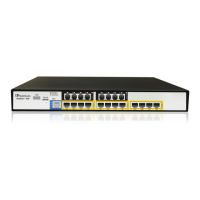User's Manual 336 Document #: LTRT-12809
Mediant 800 MSBR
26.3 Configuring Inbound IP Routing Table
The Inbound IP Routing Table page allows you to configure up to 24 inbound call routing
rules:
For IP-to-IP routing: The table is used to identify an incoming call as an IP-to-IP call
and subsequently, to assign the call to an IP Group, referred to as a source IP Group.
These IP-to-IP calls can later be routed to an outbound destination IP Group (see
Configuring Outbound IP Routing Table on page
327).
For IP-to-Tel routing: This table is used to route incoming IP calls to Trunk Groups.
The specific channel pertaining to the Trunk Group to which the call is routed is
determined according to the Trunk Group's channel selection mode. The channel
selection mode can be defined per Trunk Group (see 'Configuring Hunt Group
Settings' on page
297) or for all Trunk Groups using the global parameter
ChannelSelectMode.
The Inbound IP Routing Table provides two configuration areas:
Matching characteristics of incoming IP call, for example, prefix of destination number.
Operation (destination), for example, sends to a specific Trunk Group.
If the incoming call matches the characteristics of a rule, then the call is sent to the
destination configured for that rule.
The device also supports alternative routing if the Trunk Group is unavailable:
If a call release reason is received for a specific IP-to-Tel call and this reason is
configured for alternative IP-to-Tel routing, then the device re-routes the call to an
alternative Trunk Group. The alternative route is configured in this table as an
additional row (below the main routing rule) with the same call characteristics, but with
a destination to a different Trunk Group. For more information on IP-to-Tel alternative
routing, see 'Alternative Routing to Trunk upon Q.931 Call Release Cause Code' on
page
345.
The device can re-route (i.e., call redirection) IP-to-Tel calls to an alternative IP
destination using SIP 3xx responses. For more information, see 'Alternative Routing to
IP Destinations upon Busy Trunk' on page
346.
The device automatically re-routes an IP-to-Tel call to a different physical FXO port or
physical trunk if the initially destined FXO port or physical trunk within the same Trunk
Group is detected as out of service (e.g., physically disconnected). When the physical FXO
port or physical trunk is disconnected, the device sends the SNMP trap,
GWAPP_TRAP_BUSYOUT_LINK notifying of the out-of-service state for the specific FXO
line or trunk number. When the FXO port or physical trunk is physically reconnected, this
trap is sent notifying of the back-to-service state.
Note: You can also configure the Inbound IP Routing Table using the table ini file
parameter, PSTNPrefix (see 'Number Manipulation Parameters' on page 954)
or CLI command, configure voip > gw routing ip2tel-routing.

